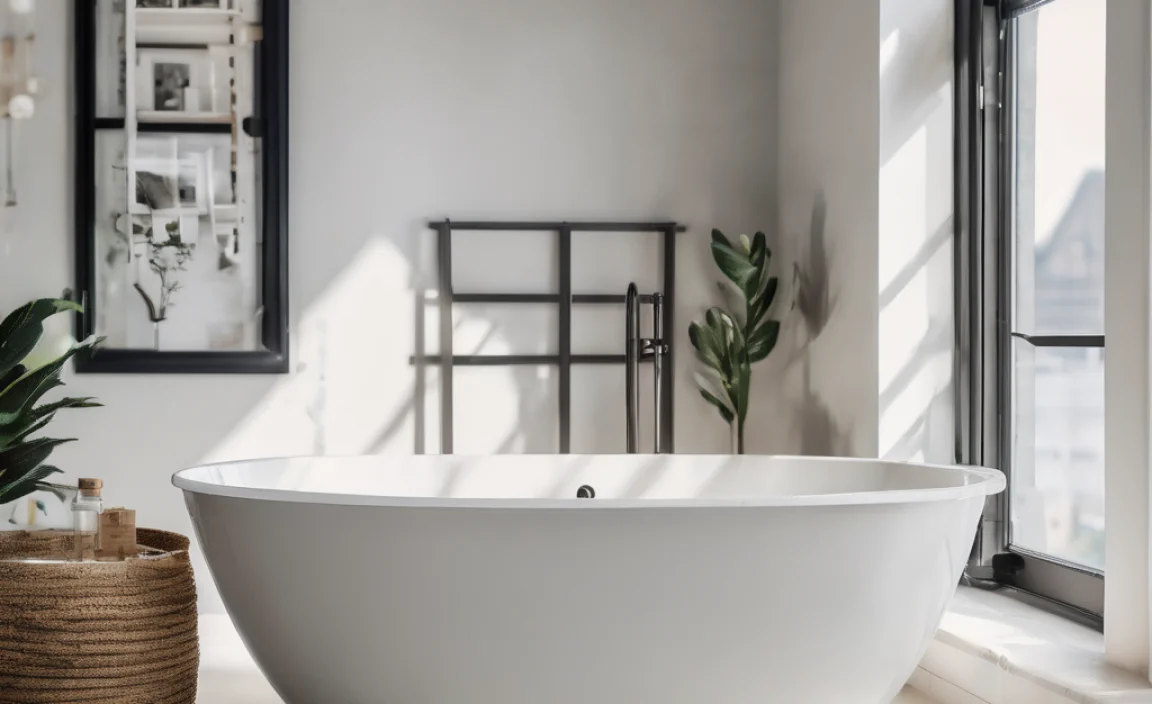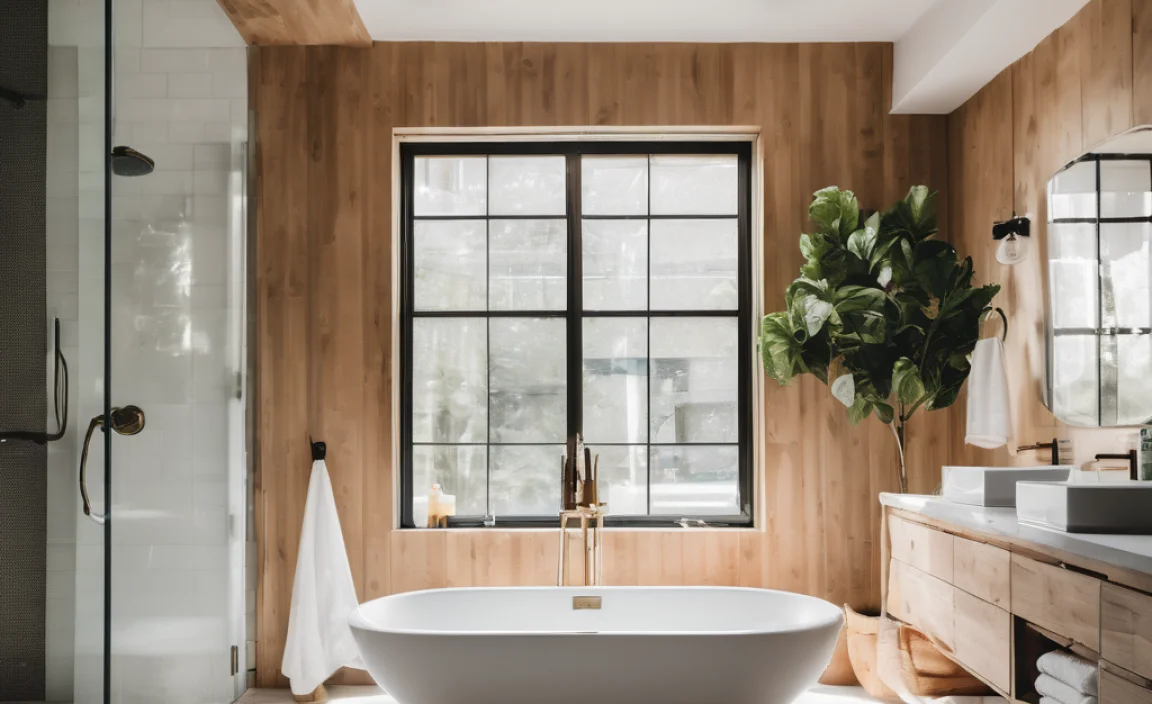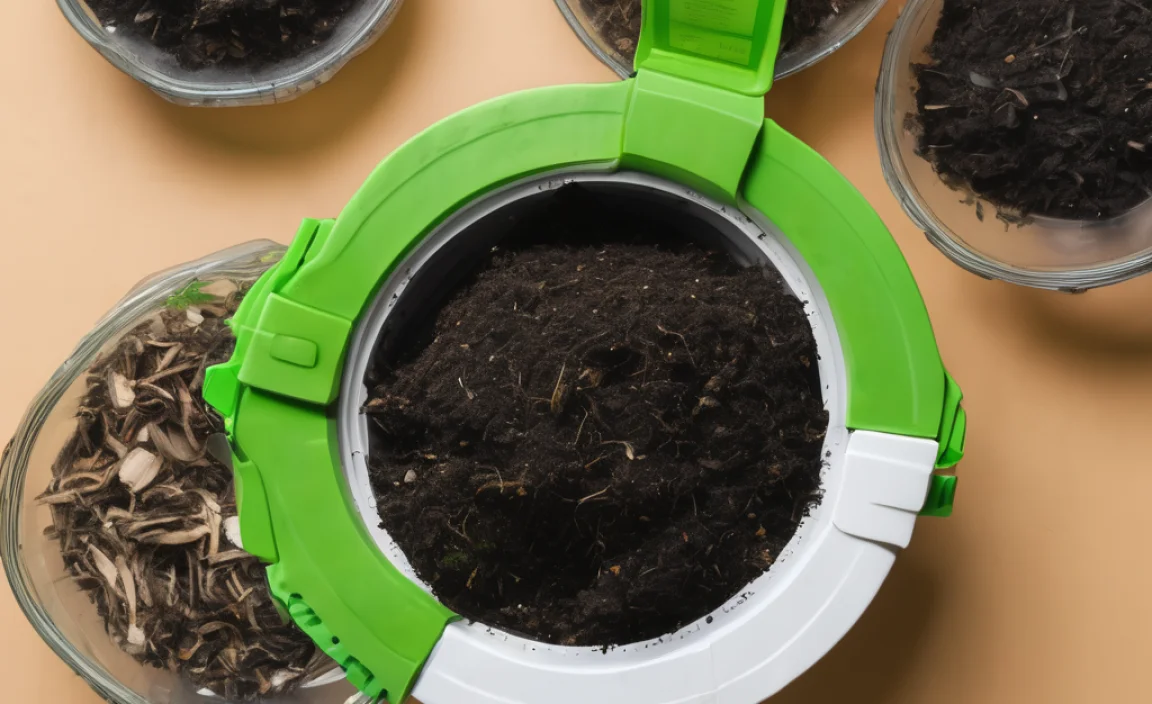Bathtubs come in a wide range of sizes! The standard rectangular tub is around 60 inches long and 30 inches wide, but you can find smaller tubs for compact spaces and larger ones for luxurious soaks. Consider your bathroom size and personal preferences when choosing the right bathtub size.
Picking out a new bathtub can feel overwhelming. There are so many shapes, materials, and features to consider. But the most important thing to think about is size! After all, you want a tub that fits comfortably in your bathroom and lets you relax.
Don’t worry, this guide will walk you through the common bathtub sizes and help you find the perfect fit for your space. We’ll cover everything from standard dimensions to unique shapes. By the end, you’ll be ready to confidently choose the best tub for your needs.
Let’s dive in and make your bathtub dreams a reality!
Understanding Standard Bathtub Sizes

When you start looking at bathtubs, you’ll quickly find that there are a few standard sizes that most manufacturers follow. These sizes are popular because they fit well in most bathrooms and offer a good balance of comfort and space efficiency.
Standard Bathtub Dimensions
The most common bathtub size is the standard rectangular tub. These tubs are typically:
- Length: 60 inches (5 feet)
- Width: 30 inches
- Height: 14-16 inches (to the top of the tub wall)
These dimensions work well for average-sized adults and fit easily into most standard bathrooms. However, keep in mind that these are just typical sizes. You might find slight variations depending on the manufacturer and style of the tub.
Other Common Bathtub Sizes
Besides the standard 60-inch tub, you’ll also find other common sizes that can be a better fit for smaller or larger bathrooms:
- Smaller Bathtubs: 54 inches long x 27 inches wide
- Larger Bathtubs: 72 inches long x 32 inches wide
Smaller tubs are great for saving space, while larger tubs offer more room to stretch out and relax. Think about how you plan to use your tub and how much space you have available when making your decision.
Bathtub Shapes and Their Sizes

Bathtubs aren’t just rectangular boxes anymore! There are many different shapes available, each with its own unique look and size considerations.
Alcove Bathtubs
Alcove tubs are designed to fit into a three-walled enclosure, making them a great space-saving option. They usually have one finished side and are installed against a wall. The standard size for an alcove tub is the same as the standard rectangular tub:
- Length: 60 inches
- Width: 30-32 inches
- Height: 14-20 inches
Drop-In Bathtubs
Drop-in tubs are designed to be installed into a framed enclosure. This gives you a lot of flexibility in terms of design, as you can customize the surround to match your bathroom’s style. Drop-in tubs come in various shapes and sizes, including:
- Rectangular: Similar to standard tubs, ranging from 60 to 72 inches long.
- Oval: Typically 60-70 inches long and 30-36 inches wide.
- Corner: Designed to fit into a corner, usually around 48-60 inches on each side.
Corner Bathtubs
Corner tubs are designed to fit snugly into a corner of your bathroom, making them a good option for maximizing space. They often have a triangular or pentagonal shape. Common sizes for corner tubs include:
- Length: 48-60 inches (on each side)
- Width: 48-60 inches (on each side)
- Height: 20-24 inches
Freestanding Bathtubs
Freestanding tubs are a statement piece in any bathroom. They stand alone and don’t require an enclosure. This gives you a lot of flexibility in terms of placement, but they do require more space. Freestanding tubs come in a variety of shapes and sizes, such as:
- Oval: 60-72 inches long and 30-36 inches wide.
- Slipper: 60-72 inches long and 28-32 inches wide.
- Rectangular: 60-72 inches long and 30-36 inches wide.
Freestanding tubs often have a deeper basin than other types of tubs, providing a more immersive soaking experience. They can be a showstopper in the right bathroom.
Japanese Soaking Tubs
Japanese soaking tubs, also known as Ofuro tubs, are designed for deep soaking in a seated position. They are typically shorter and deeper than traditional bathtubs. Common sizes include:
- Diameter: 40-50 inches
- Height: 24-30 inches
These tubs are perfect for relaxation and meditation. They are a great option if you prefer to sit upright while bathing.
Bathtub Size Considerations

Before you buy a bathtub, there are several factors you should consider to ensure it’s the right fit for your bathroom and your needs.
Bathroom Size and Layout
The size of your bathroom is the most important factor to consider. Measure your space carefully and make sure the tub you choose will fit comfortably without making the room feel cramped. Think about the placement of other fixtures, like the toilet and sink, and make sure there’s enough room to move around easily.
Your Height and Build
Consider your height and build when choosing a bathtub. If you’re tall, you’ll want a tub that’s long enough for you to stretch out comfortably. If you’re wider, you’ll want a tub that’s wide enough to accommodate your body. Sit in a few different tubs at the store to get a feel for what size and shape works best for you.
Water Heater Capacity
Larger bathtubs require more hot water to fill. Make sure your water heater can handle the capacity of the tub you choose. If your water heater is too small, you may end up with a cold bath. Check the specifications of your water heater and compare it to the tub’s water capacity.
If you are unsure, you may need to contact a local plumber for advice. You can find qualified plumbers at websites like MyBuilder
Doorway and Hallway Widths
Don’t forget to measure the width of your doorways and hallways! You need to make sure you can actually get the tub into your bathroom. It’s a common mistake to overlook this detail, and it can lead to a lot of frustration on installation day.
Bathtub Size Chart
Here’s a quick reference chart to help you compare different bathtub sizes:
| Bathtub Type | Typical Length | Typical Width | Typical Height |
|---|---|---|---|
| Standard Rectangular | 60 inches | 30 inches | 14-16 inches |
| Alcove | 60 inches | 30-32 inches | 14-20 inches |
| Drop-In (Rectangular) | 60-72 inches | 30-36 inches | 18-24 inches |
| Drop-In (Oval) | 60-70 inches | 30-36 inches | 18-24 inches |
| Corner | 48-60 inches (each side) | 48-60 inches (each side) | 20-24 inches |
| Freestanding (Oval) | 60-72 inches | 30-36 inches | 22-28 inches |
| Freestanding (Slipper) | 60-72 inches | 28-32 inches | 24-30 inches |
| Japanese Soaking Tub | 40-50 inches (diameter) | 40-50 inches (diameter) | 24-30 inches |
Installation Considerations
Installing a bathtub can be a DIY project, but it’s often best left to the professionals. Here are a few things to keep in mind:
DIY vs. Professional Installation
If you’re comfortable with plumbing and carpentry, you may be able to install a bathtub yourself. However, it’s a complex job that requires careful attention to detail. If you’re not confident in your abilities, it’s best to hire a licensed plumber. A professional can ensure the tub is installed correctly and safely, and they can also handle any necessary plumbing modifications.
Plumbing Requirements
Installing a new bathtub may require modifications to your existing plumbing. You may need to move or replace pipes, install new drain lines, or upgrade your water supply lines. A plumber can assess your plumbing system and make the necessary changes to ensure your new tub functions properly.
Building Codes and Permits
Depending on your location, you may need to obtain a permit before installing a new bathtub. Check with your local building department to find out what permits are required. A professional plumber will be familiar with local building codes and can help you navigate the permitting process.
You can also check the EPA website for more information on building codes and permits.
Cost Considerations
The cost of a bathtub can vary widely depending on the size, shape, material, and features. Here’s a general overview of what you can expect to pay:
Bathtub Price Range
Here is a general range of costs for the different types of bathtubs available:
- Standard Alcove Tub: $200 – $800
- Drop-In Tub: $500 – $2,000
- Corner Tub: $800 – $3,000
- Freestanding Tub: $1,000 – $5,000+
- Japanese Soaking Tub: $1,500 – $6,000+
Installation Costs
In addition to the cost of the tub itself, you’ll also need to factor in installation costs. These can vary depending on the complexity of the job and the plumber’s hourly rate. On average, you can expect to pay between $500 and $1,500 for professional bathtub installation.
Additional Expenses
Don’t forget to budget for additional expenses, such as:
- Plumbing modifications: $100 – $500+
- Permits: $50 – $200
- New fixtures (faucets, showerheads): $100 – $500+
- Tile or surround: $200 – $1,000+
Frequently Asked Questions
What is the standard size of a bathtub?
The standard size for a rectangular bathtub is 60 inches long, 30 inches wide, and 14-16 inches high.
What size bathtub is best for a small bathroom?
For a small bathroom, consider a smaller alcove tub (54 inches long) or a corner tub to save space.
How do I measure for a new bathtub?
Measure the length, width, and height of the space where the tub will be installed. Also, measure doorways and hallways to ensure the tub can fit through.
Can I replace my bathtub with a larger one?
It depends on the size of your bathroom and the capacity of your water heater. Make sure the larger tub will fit comfortably and that your water heater can handle the increased water volume.
What is the best material for a bathtub?
Common bathtub materials include acrylic, cast iron, and steel. Acrylic is lightweight and affordable, cast iron is durable and retains heat well, and steel is a budget-friendly option.
How much does it cost to install a new bathtub?
Professional bathtub installation typically costs between $500 and $1,500, depending on the complexity of the job.
Do I need a permit to replace my bathtub?
It depends on your local building codes. Check with your local building department to find out if a permit is required.
Conclusion
Choosing the right bathtub size is key to creating a comfortable and functional bathroom. By understanding the standard sizes, shapes, and considerations outlined in this guide, you’ll be well-equipped to make an informed decision. Remember to measure your space carefully, consider your personal preferences, and factor in installation costs. With a little planning, you can find the perfect bathtub to suit your needs and transform your bathroom into a relaxing oasis. Happy bathing!


